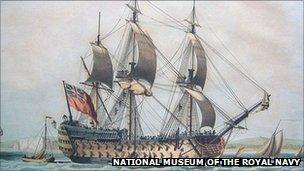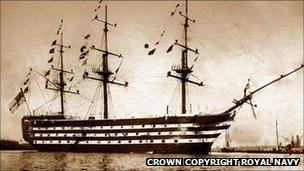The wreck that revealed the Mary Rose
- Published

The ship sank in shallow water just beyond the entrance to Portsmouth harbour
Few of the tourists who gaze up to admire one of London's most famous landmarks, Nelson's Column, would realise that its column's topmost point is made from the salvaged remains of an unheralded 18th Century warship.
But the HMS Royal George can lay an even greater claim to posterity than providing the foundations of the world-famous statue in honour of perhaps the most celebrated naval hero in British history.
According to naval historian Dr John Bevan, the largely forgotten flagship, which sank in the Solent at Spithead in August 1782, helped divers to locate the wreckage of the Mary Rose in the 1830s - a full 150 years before the stricken vessel was raised from the seabed.
More than 900 people died when the Royal George sank, including 300 women and 60 children who were visiting the ship which was due to head for Gibraltar with HMS Victory.
'Macabre reminder'
It was the biggest loss of life in British waters.
The 100-gun battleship had been heeled on to its side for repairs to be carried out on its sea cock - a valve on the hull - when it began to take in water though its open gun ports. It capsized and sank.
"For weeks after the tragedy, bodies washed ashore at Southsea, Gosport and Ryde and were buried in mass graves along the seafront," said Royal Marines Museum historian Stuart Haven.
The Royal George remained in shallow water just beyond the entrance to Portsmouth harbour for many years, "her masts standing above the water a macabre reminder of the tragedy," Mr Haven said.
Some 50 years later the pioneering divers Charles and John Deane tried to recover the battleship, which had become a hazard to other vessels.
Between 1834-36 the brothers undertook a series of dives.
Christopher Dobbs, of the Mary Rose Trust, said: "Some fishermen came and asked them if they could take a look as their nets kept getting caught on something nearby."
He said a dive by John Deane, 1km north east of the Royal George, revealed "some timber and guns from the Mary Rose".
Dr Bevan, chairman of a historical diving society which has researched the Deane brothers, said: "John Deane found a piece of wood, searched around that piece of wood in a circle and he bumped into a cannon on the seabed sticking up 4ft.
"He pulled it up and when they cleaned it off found the Tudor rose which identified it from the wreck of the Mary Rose."

HMS Victory, which is shown here, was almost identical to HMS Royal George
John Deane dived on the Mary Rose for about two years and brought up a 15ft section of the mast, bows and arrows, human remains and lots of cannon-balls, Dr Bevan said.
But as the Mary Rose was buried under a thick layer of clay, the dives were not very productive and John Deane abandoned them, said Dr Bevan.
Henry VIII's famed flagship would remain under the water until historian and diver Alexander McKee began his search for wreckage in the Solent in the 1960s.
The Mary Rose, which sank on 19 July 1545, was finally brought to the surface on 11 October 1982 after 437 years submerged in the Solent.
Work to clear the wreck of the Royal George took place between 1839 and 1844 and parts were recovered, including many bronze cannon.
It was these which were melted down to form part of Nelson's Column.
But, unlike the Mary Rose, there could be no 20th Century raising of the Royal George.
As it was cleared it was progressively blown to pieces and every part removed, leaving a clear sea-bed.
In 1840, a huge controlled explosion by the Royal Engineers shattered windows as far away as Portsmouth and Gosport.
- Published2 August 2011
- Published19 February 2011